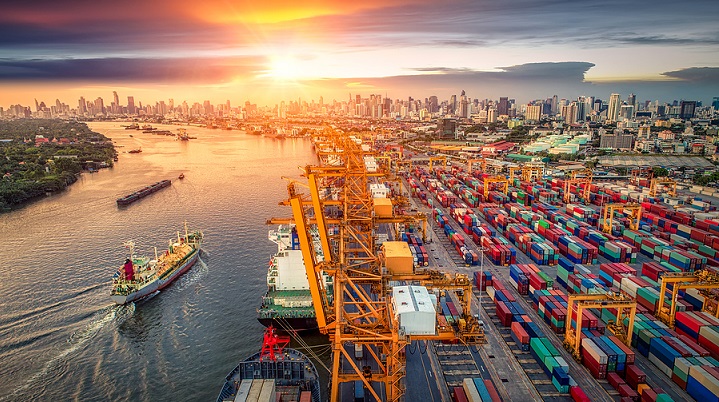What’s the connection between the Covid vaccine rollout in the US and Europe and increased container costs and shipping delays for retailers in Australia? It’s all a matter of supply and demand. Stores are back open and people are shopping again in the US, UK, France, Germany and other European countries that have fully vaccinated over half of their populations, which is straining global supply chains that are still badly impacted by Covid-19. “Consumer demand is outpacing container
ainer supply and vessel space,” Jamie Dixon, TMX’s director of supply chain, told Inside Retail.
Ninety per cent of ships are currently being used to meet demand, Dixon said, and air freight remains limited due to reduced international air travel.
On top of this, Covid-19 outbreaks at ports in China have led to temporary shutdowns and shipping delays, while backlogs at ports in Los Angeles and Rotterdam, some of the world’s busiest docks, have caused container shortages and price increases.
Container prices have increased each week for the last 19 weeks, according to Drewry’s World Container index. Last week, the composite price of a 40-foot container was US$9,817.72, a 2.1 per cent increase from the previous week and a 351 per cent increase from the same week last year. Prices are expected to rise again this week.
This is bad news for retailers around the world, but especially in Australia.
“Shipping lines are making decisions based on volume not based on who needs it, so unfortunately, retailers in Australia are having to pay a premium to attract the boats,” Dixon said.
“To put it simply, Australia is a small population with lower volumes of product coming to our shores, so shipping lines are more likely to prioritise regions like the US or Europe with much more volume than us.”
The upside of lockdowns
Wesfarmers CEO Rob Scott acknowledged the problem on an earnings call with investors last week.
“We’re seeing a lot of disruption in global container shipping markets, and that is flowing through to some delays and also higher transportation costs,” he said.
Still, Scott said, Wesfarmers’ retail businesses, which include Bunnings, Officeworks, Kmart, Target and Catch, are in a better position than they were last year.
“[W]e’ve adapted our ordering processes and we’re leveraging very strong strategic relationships we have with shipping lines. So, we’re managing that, albeit it is coming at a higher cost,” he said.
Ironically, the lockdowns that have forced many Australian retailers to close their bricks-and-mortar stores in recent weeks may be helping to mitigate the impact of supply chain disruptions.
“In the short term this hasn’t been as detrimental as you might think,” David White, national retail lead at Deloitte Australia, told Inside Retail.
“The extensive store closures due to the nationwide lockdowns have meant that many retailers have been faced with rising inventory levels, as decisions were made on stock purchases a number of months ago.”
“However, the disruption is now really starting to bring significant cost increases which the retailers will have to try and pass on to consumers. There will be some big decisions to be made by retailers on pricing to get the balance right between moving stock through the business without destroying its underlying profitability.”
The rise of onshoring
Retailers that source most of their products from overseas have been the hardest hit by supply chain disruptions.
“Home and leisure goods, furniture and electronics coming out of Asia are all experiencing significant delays of up to four to six weeks,” Dixon said.
Similarly, retailers with less control over access to global supplies will be more vulnerable.
“In particular, major global retail brands will typically dictate how much and what type of inventory they will make available to each geography,” he said.
“With demand in Europe and North America rebounding very strongly, there is a significant risk that Australian retailers won’t be able to get their hands on these global branded products, or at least as much as they like.”
On the flip side, retailers that source products locally are in a better position to avoid stock shortages and price increases. This may lead businesses to secure new suppliers and potentially onshore some of their production.
“Publishers are looking at how they can print in each region and avoid sending containers across the planet,” Booktopia CEO Tony Nash told Inside Retail.
“Shorter print runs in Australia that make the product available for immediate sale addresses a lot of the global supply chain and logistics issues that we are currently contending with globally.
“Print-on-demand is also a mature printing process where someone places an order for a book and the printer has the technology to only print one copy. Most of that is handled in Australia now, removing any need to deal with global supply chains.”
What it means for Christmas trading
Supply chain disruptions couldn’t come at a worse time for retailers with the peak trading period just around the corner. Scott sought to allay concerns about Wesfarmers’ supply levels on the call with investors last week.
“There are some challenges getting stock there, but generally our businesses are well positioned to make sure we’re going to have stock on shelves in the lead-up to Christmas,” he said.
However, White believes stock shortages are inevitable.
“[W]e are going to see some shortages on popular products as the global economy rebounds and the stock that is available will likely be prioritised to other regions before Australia,” he said.
“We can expect sales to be brought forward as consumers rush to get in ahead of others, and we may see the level of discounting reduce as demand outstrips supply.”
With this in mind, retailers should aim to get their hands on stock as soon as possible, Dixon said.
“A retailer’s availability of stock will ultimately become a competitive advantage come Christmas time.”

